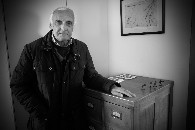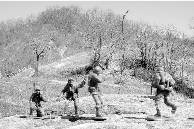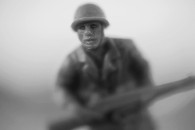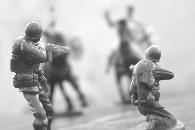Giocavamo nella/alla guerra - foto attalmi
Menu principale:
Giocavamo nella/alla guerra
Giocavamo nella/alla guerra è un progetto sulla generazione nata e cresciuta sulla Linea gotica, gli oltre 300 km di linea difensiva disseminata di fortificazioni costruita dall’esercito tedesco in Italia durante le fasi finali della Seconda guerra mondiale. Una rete di bunker, trincee, camminamenti tra il Tirreno e l’Adriatico, ultimo sbarramento per gli alleati verso la Liberazione.
I bambini della Linea Gotica, coloro che da piccoli vissero l'invasione delle loro terre da parte dell'esercito tedesco, videro i propri genitori rastrellati o, nella migliore ipotesi, costretti a lavorare per creare la linea difensiva tedesca e riuscirono, malgrado tutto, a continuare ad essere bambini: nella vita quotidiana, nel gioco di tutti i giorni.
Il gioco quindi come mezzo di interazione, come aiuto nell' esorcizzare nuovi accadimenti improvvisi e traumatici. Il gioco di guerra vissuto anche come sistema per metabolizzare ciò che si è vissuto.
Una testimonianza per raccontare con ottica diversa gli ultimi avvenimenti della Seconda guerra mondiale in Italia, intorno e su quella Linea gotica costruita per fermare il più possibile gli Alleati.
Filo di unione i soldatini di plastica simbolo dei giochi di guerra che in mano ai bambini diventano personaggi reali, veicoli dei loro sentimenti, paure e atti eroici. Per poi tornare ad essere semplicemente giocattoli, usati per combattere con la fantasia guerre impossibili dove nessuno si fa male per sempre.
Giocavamo nella/alla guerra (We played at war/in the war) is a project on the generation born and raised on the Gothic Line, the over 300 km of defensive line scattered with fortifications built by the German army in Italy during the final stages of the Second World War. This was a network of bunkers, trenches, walkways between the Tyrrhenian and the Adriatic, the last barrier for the allies towards Liberation.
This is about the children of the Gothic Line, those who as a child lived through the invasion of their lands by the German army, saw their parents rounded up or, at best, forced to work to help create the German defensive line and managed, despite all, to continue being children: in everyday life, in everyday playful activities.
Playing was therefore a means of interaction, as an aid in exorcising new sudden and traumatic events. The war game was also lived as a system to metabolize what was experienced, a testimony to tell the latest events of the Second World War in Italy around and on the Gothic Line which was built to stop the Allies as much as possible.
Common thread: the plastic toy soldiers as a symbol of war games, which in the hands of children become real characters, vehicles of their feelings, fears and heroic acts to end up becoming simple toys again, used to fight with the fantasy impossible wars where nobody gets hurt forever.



